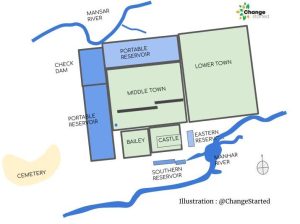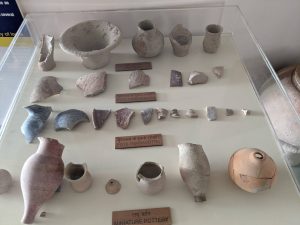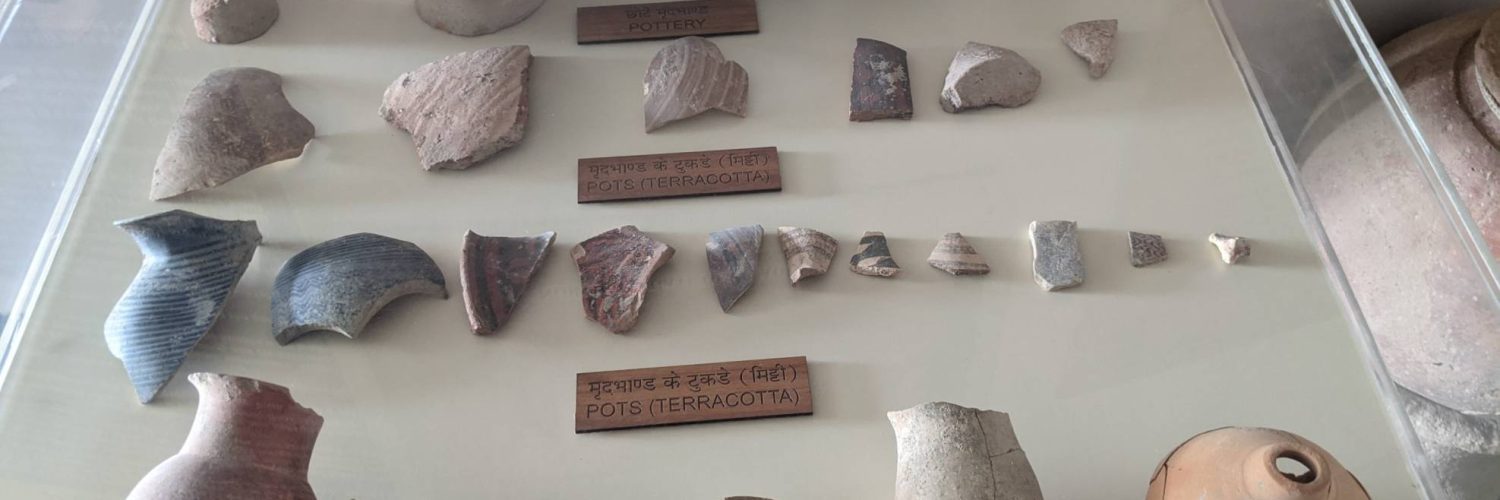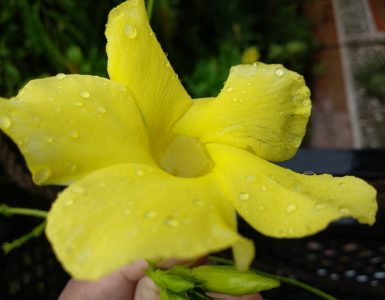Amongst many ancient civilizations that have been discovered, Dholavira has a distinguished position. Dholavira is India’s most prominent archaeological site, belonging to the Indus Valley Civilization.
Dholavira civilization (3000 BCE to 1700 BCE) speaks volumes of the ability and expertise of the people during the Harappan and Indus Valley Civilization periods. As a result of the extensive excavations over the years, Dholavira has emerged as a major Harappan city remarkable for its exquisite town planning, monumental structures, aesthetic architecture, and water storage system.
Dholavira is unique in many aspects and has one of the ancient world’s most efficient drainage and water management systems.
About Dholavira
Dholavira is a small village located at a corner of an isolated Island of Khadir in the Great Rann of Kachchh in the western Indian state of Gujarat.
However, this small village has a rich ancient past; this site is the fifth largest Harrapan civilization in the subcontinent after Mohen-jo-Daro, Ganweriwala, and Harappa in Pakistan and Rakhigarhi in Haryana of India.
The cityscape consisted of a citadel, middle town, and lower town, several fortifications, reservoirs, and an amphitheater for the congregation. Unlike other Harappan sites, including Harappa itself and Mohenjo-Daro, which were built of brick, buildings in Dholavira are built of stone.
The ancient site known as Kotada (large fort) spans an area of about 100 hectares, and nearly half (around 54 acres) has been devoted by the Dholavira civilization. The site is surrounded by two seasonal water streams (nallahs), Mansar in the north and Manhar in the south.
A variety of funerary structures is another feature of exceeding importance, throwing new light on the socio-religious beliefs, thereby indicating the presence of composite ethnic groups in the Indus population of Dholavira. The identification of a stadium with seating arrangement and the introduction of Middle Town added a new feature to the Harappan studies.
Dholavira has the unique distinction of producing a large signboard that includes an inscription of ten large-sized signs of the Harappan script, indeed the oldest signboard in the world.
What is unique about the Dholavira Civilization?
Dholavira is unique because, if we look at several ancient civilizations around the globe, they are known to be established around rivers and giant water bodies for obvious reasons – Roman civilization near River Tiber, Ancient Egyptians near River Nile, Mesopotamians in the Fertile Crescent on the Tigris/Euphrates rivers, the Ancient Chinese on the Yellow River.
Even the civilizations found in the Indian subcontinent are called Indus Valley Civilization because the settlements were largely made near the River Indus.
Though the Arabian Sea was a few miles away from Dholavira, the only source of fresh water for this ancient civilization was the two small seasonal water streams – Mansar and Manhar. The seasonality of the streams meant water was precious, and it needed to be preserved and collected in large capacities.
This makes Dholavira a unique ancient civilization that made outstanding efforts to conserve water. There are huge water storage systems at Dholavira – there were massive reservoirs, three of which are currently exposed, and they were used for storing water brought by rains or for storing water diverted from two nearby rivulets.
Dholavira’s water management system consisted of a sophisticated water network system of channels and reservoirs, the earliest found anywhere in the world, built completely of stone. The kind of efficient system developed for the conservation, harvesting, and storage of water speaks eloquently about their advanced hydraulic engineering.

The water conservation at Dholavira was developed based on rainwater harvesting to support life in a region that was largely arid and dry.
The inhabitants of the Dholavira civilization would have realized that depending on rainwater was not a reliable option for sustainability.
They developed large rock-cut reservoirs, located on the eastern and southern sides and also constructed huge stone drains that directed the water to the western and northern section of the lower town separated by broad bunds, creating in effect a series of large water tanks.
An impressive well was located in the castle and is possibly the earliest example of a rock-cut well.
Dholavira drainage system was also as intricate, with many small and large drains intersecting each other to link to an arterial drain. Many of these drains are also covered from the top.
Many pipes & pots have also been discovered from the site, which also indicates the Harappan’s abilities in ensuring optimum usage of water.
Every drop of water was conserved through a highly expansive town planning system and an efficient water preservation system that supported life for more than 1200 years against a harsh, hot, arid climate – to ensure survival.
The excavated remains of the complete Dholavira water management system distinguish this site from other Harrapan sites of the ancient world.
Here is a video on Dholavira elucidating our experience at this ancient site.
History of Dholavira Harappan
Dholavira Harappan civilization flourished from about 3000 BCE to 1700 BCE. The archaeological excavations at the site have revealed seven significant cultural stages documenting the rise and fall of this Dholavira Civilization.
The history of Dholavira has a stratified account of these seven successive stages. (The excerpts below were picked from the Archeological Museum at Dholavira.)

Stage I starts right from the virgin ground. The first settlers came with advanced ceramic techniques, copper working, lithic industry, bead making, stone dressing, and certain principles of planning and architecture. They constructed a formidable fortification (11 m thick at the base) around the settlement. The houses were made of molded mud bricks of standard sizes.
Stage II is marked by the widening of the fortification, an increase in ceramic forms, decorations, and the number of minor antiquities.
Stage III is a very creative period for the Dholavira Civilization. The small settlement grew into a large town with two fortified major divisions, annexes, and water reservoirs, all within a peripheral wall. The existing fortified settlement was made into a Citadel, and another fortified subdivision was added to the west. These two sub-divisions have been designated as Castle and Bailey, respectively.
Towards the closing decades of Stage III, the entire settlement witnessed a natural catastrophe, most probably caused by an earthquake of severe magnitude. Consequently, large-scale repairs were executed and significant changes were made in the planning. The city wall was also extended eastwards. At least, during that sub-stage, the monumental gateways and their front terraces had been introduced. Now, the entire settlement has reached its fullest growth. The cityscape possessed three principal divisions: ceremonial ground and water reservoirs.
Stage IV belongs to the classical Harappan Culture. The city of Stage III was thoroughly maintained along with monumental structures such as gateways, fortification walls, and the drainage system.
The famous inscription of ten large-sized signs of the Harappan script found in a chamber of North Gate should also pertain to this stage. All the classical Harappan elements, such as pottery, seals, lithic tools, beads, weights, and other items of gold, copper, stone, shell, and clay, are now abundant. Among the most impressive items are elements of functional pillars and free-standing columns made out of locally available limestone.
Stage V is characterized by the general decline, particularly in the maintenance of the city, as is more vividly reflected in Citadel. However, the other items, such as pottery, seals, etc., continued in their developed forms and styles. This stage was followed by temporary desertion of the site.
Stage VI presents an entirely different fond of the Harappan culture that has been widely distributed in other parts of Gujarat. The culture has undergone a drastic transformation by incorporating its diverse pottery traditions from Sindh (Pakistan), South Rajasthan, and Gujarat. In contrast, many Harappan traditions were still present in pottery, stamps, seals, and weights, albeit in changed form and style. At Dholavira, this late Harappan Culture is present. The one-time city relapsed into a much smaller settlement with a different inner layout. Having lived there for about a century, the late Harappans abandoned the settlement.
Stage VII people, the newcomers, appeared closely related to their predecessors of Stage VI as the ceramic assemblages remained the same. Strangely enough, the new people constructed their houses in an entirely new form that is circular. All the urban attributes are conspicuous by their absence.
Thus, the urbanization that had humble beginnings in Stage I and went on developing through several Stages became deurbanized by the time of the advent of Stage VII.
The site was never occupied after that.






Add comment